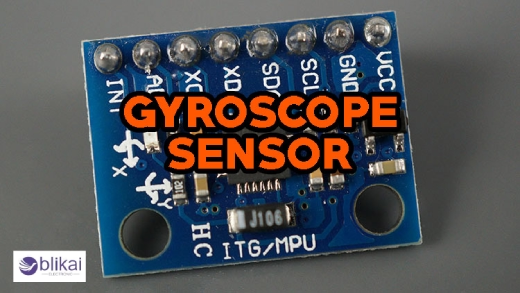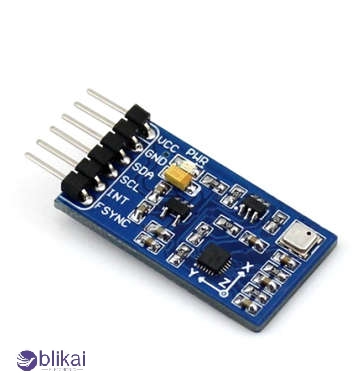Gyroscope Sensor: Working, Types & Applications

Do you ever wonder how your phone knows when it is tilted? Are drones able to maintain balance in mid-air? Gyroscope sensors work quietly in the background. In addition to detecting angular movement, this device also senses orientation. This component can be found in smartphones, vehicles, spacecraft, and even game controllers. Smart, stable, and balanced are all made possible by this tiny technology. But what is the actual process? Is there a wide variety? Is there a reason why it is used so widely? Let's take a closer look.
What is a Gyroscope Sensor?

Gyroscopes are devices that measure angular velocity, namely how fast things spin or rotate. While it doesn't provide location information like a GPS, it gives you information about the direction and speed of movement of objects. As a balance keeper, it keeps you in check. It may contain spinning masses, moving elements, or even tiny laser beams that bounce around inside. The internal reactions change when the device rotates, which translates into readable information. Despite its simplicity, it is surprisingly complex in terms of technology.
Almost every gadget has a gyroscope. Turning the phone sideways rotates the screen on smartphones. Stability systems are crucial to cars. What are the differences between planes and drones? In order for the sky to stay level, they must be level. You can even track your head movements in real time when you wear VR headsets with gyros. There's something about it that makes modern technology feel smooth, responsive, and even magical behind the scenes.
Working Principle
Gyroscope sensors are based on angular momentum, or the principle that spinning objects resist changes in orientation. An inherent characteristic of mechanical gyros is the ability to rotate freely in multiple directions thanks to the use of a spinning wheel or disc. Inertia prevents the spinning disc axis from moving when the base of the gyro moves. This resistance or shift is measured by sensors, which are converted into electrical signals showing how much rotation is occurring.
Smartphones and drones don't always have spinning parts in gyroscopes. The technology behind many of these devices is MEMS (Micro-Electro-Mechanical Systems). Structures that vibrate are used to drive these tiny gyros. During rotation, this vibrating element shifts due to the Coriolis effect. Angular velocity data is converted from this movement by sensors. Besides being fast and compact, it is also extremely precise. All gyros detect how objects move through space, regardless of whether they are mechanical or MEMS-based.
Types of Gyroscope Sensor
Mechanical Gyroscope
An old-school gyroscope, this is what you're looking at. Gimbals mounted on spinning rotors allow the device to rotate freely in multiple directions. As long as the base doesn't move, the rotor stays stable. Orientation changes are detected by measuring that resistance to motion. Some aircraft and ships that require precision and ruggedness still use mechanical gyros, even though they aren't common in everyday gadgets anymore. They're big, heavy, and require careful maintenance-but they laid the foundation for everything that came after them.
MEMS Gyroscope (Micro-Electro-Mechanical Systems)
Modern electronics rely on MEMS gyros for their small but powerful size. Almost any compact device that needs motion tracking uses them, such as smartphones, drones, and wearables. A spinning wheel isn't present on these. A tiny vibrating element is used instead. These elements shift slightly when the device rotates because of the Coriolis effect. As a result, the system receives electrical signals telling it how it is moving. For consumer electronics, MEMS gyros are efficient, cheap, and easy to mass produce.
Fiber Optic Gyroscope (FOG)
The technology is getting higher and higher now. Rotation is detected by fiber optic gyroscopes by using light. By splitting a laser beam of light into two, it is sent in opposite directions around a coil of optical fiber. A phenomenon known as the Sagnac effect causes phase shifts in the beams when the system rotates. How much rotation has occurred can be determined by the amount of shift. As there are no moving parts in FOGs, they are extremely accurate and durable. Precision is an essential requirement for aerospace, submarines, and other critical navigation systems.
Ring Laser Gyroscope (RLG)
In Ring Laser Gyroscopes, light travels in a closed triangular path instead of fibers as in fiber optics. It is still the Sagnac effect that causes a measurable shift in light waves' interference when rotation occurs. Aircraft of all kinds use them, including commercial and military ones. Due to the fact that nothing physically moves, they're highly precise and resistant to wear. They are expensive, but they are mostly used in specialized fields.
Vibrating Structure Gyroscope
In this category you will find things like tuning fork gyroscopes. Their vibrating elements oscillate in opposite directions, like two arms. Vibration patterns are altered when Coriolis forces are applied. Angular velocity is calculated by sensors detecting this change. The gyros are mostly used in automotive applications, gaming controllers, and aviation instruments. In terms of cost, performance, and simplicity, they strike a nice balance.
Applications
Smartphones and Tablets
Your phone screen likely turns when you rotate it, thanks to gyroscopes and accelerometers working together. Gyroscopes detect any tilts or spins to improve orientation of the screen, motion-based games and AR features as well as stabilizing the camera; so next time your videos look smooth when recording on phone - thank your gyroscope!
Drones and UAVs
Drones rely heavily on gyroscope sensors to maintain flight stability during flight. By continuously adjusting its motors based on pitch, yaw, and roll data from these sensors, drones' motors remain at optimal performance and remain stable during their flights. Without them present, drone control becomes almost impossible under windy or unsteady weather conditions while GPS-denied environments rely heavily on them as balance and direction maintainers until satellite signals return again.
Automotive Systems
Gyroscopes play an invaluable role in modern cars, making them smarter than ever. An Electronic Stability Control (ESC) system detects rotational movement and automatically brakes to prevent skidding; additionally gyros can detect rollovers, provide lane-keeping assistance and support autonomous driving, responding intelligently and safely to changes in space.
Aviation and Aerospace
Gyroscopes play an important role in planes and spacecraft. The inertial navigation system (INS) is used by pilots and computers onboard aircraft to determine the craft's orientation and trajectory even without GPS. Military jets, rockets, and satellites require sensors that are extremely accurate and reliable, especially for missions that require precision.
Virtual Reality (VR) and Gaming
With gyros, virtual reality becomes more real. Gyroscopes in VR headsets track head movements and adjust the virtual environment accordingly. The experience becomes immersive and responsive as a result. The same technology can be found in gaming controllers and motion-sensing remote controls, where tilts, shakes, and spins translate into in-game actions.
Robotics and Automation
In order for robots, especially autonomous ones, to move properly, they need a sense of balance and direction. Orientation-based decisions are made by robots with help from gyroscope sensors. Gyros ensure precision movement of industrial robot arms, delivery bots navigating hallways, and delivery bots navigating hallways.
Marine and Submarine Navigation
It is important for ships and submarines to maintain their heading and stability through the use of gyroscopes. The Inertial Navigation System of submarines relies on gyros because GPS doesn't work underwater. By tracking orientation and rotation, it assists in navigation without needing to surface.
Final Verdict
The gyroscope sensor might seem small, but how big is its impact on modern technology? It's huge. You'll find it quietly tracking motion, maintaining balance, and ensuring precision on everything from your pocket-sized phone to soaring aircraft. In the absence of it, our devices would feel clunky, drones would wobble, cars would be less safe, etc. Unsung heroes often go unnoticed, yet their importance cannot be overstated. The advancement of technology will lead to gyroscopes becoming even smarter, smaller, and more accurate, silently shaping movement-aware innovation of the future.
Some images are sourced online. Please contact us for removal if any copyright concerns arise.
What are Wireless Sensor Networks : All Explained
What is Optical Sensor ? Overview and Applications
Tilt Sensor Technology: Types, Advantages & Applications
How Do Motion Sensors Work? Types & Applications
What Steering Angle Sensor is :Principle,Features and Applications
ACS712 Current Sensor:Principle,Features and Applications
Analog and Digital Sensors:Types and Applications
MLX91221KDF-ABF-120-RE Melexis Current Sensor
Introduction to Current Sensor ABF025
Differential Pressure Sensor: Working, Applications and Types










